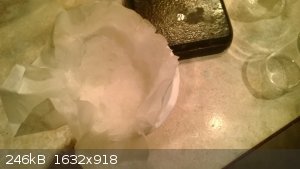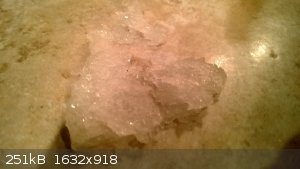
numos - 23-11-2014 at 21:17
A few weeks ago I wanted to make s small amount of Isopropyl nitrite, from which the biggest joy was setting it alight, since it burns so fiercely. So
I wanted to make a slightly larger batch to remake the "whoosh bottle" experiment on a more powerful scale.
So I set up the Nitrite solution in an RBF in an ice bath, and added the alcohol mixture through a dropper funnel. I let that drip for an hour or so
and then left it since it was still bubbling. About an hour later I came back to it (still under ice) and poured it into a large beaker.
So what I had in the RBF was a clear line of separation, with about 1cm of yellow oil at the top and a greenish solution below. As soon as the
contents hit the beaker I started seeing an imitation of the hot ice reaction. As I poured it into the beaker I built a sort of tower. I stuck my
gloved hand into it, and I've never felt anything like it. Think like dissolving Styrofoam in acetone and resulting paste that follows, only less
gooey and not stuck together. At that point I did what I could to get the remaining product (filter) although it wasn't much.
Some things to note, as soon as the stuff started solidifying it started bubbling vigorously and evolved NOx gases, the solid mass did
not heat up like Sodium acetate does. The mass itself is pH neutral. It dissolves in water, and in Acetone it does not dissolve but gives a
thick slurry, like a slushy.
According to Wikipedia, decomposition of Alkyl nitrites forms "polymerization products", is that what this is?
Filtering the slush:

A close up shows that it consists of tiny little flakes, apparently clear.

Edit: I just took a closer look, it is not made from tiny flakes. It's literally goop, there are no distinguishable particles, and when prodded it
acts like the Styrofoam I mentioned earlier. It is also still happily bubbling away (not Nitrogen oxides) I'm going to let a small amount dry and
update later.
[Edited on 11-24-2014 by numos]
TGT - 23-11-2014 at 23:53
Could the Isopropyl be tainted? Where did you a purchase it, that's all I can really think of, although I have never run in to something like this
before. I am sure others will have a good explanation.
TGT
numos - 24-11-2014 at 10:49
It was drug-store grade, 91% with the inactives being water. I know for a fact that my beaker must have been dusty for it to initiate that.
UnintentionalChaos - 24-11-2014 at 19:08
Supersaturated solution of alkali sulfate or bisulfate salt. I've had a large flask solidify rapidly during preparation.
Metacelsus - 24-11-2014 at 19:11
Where would the sulfate have come from? The acid used is hydrochloric, right?
Try burning it, to see if it is organic.
numos - 25-11-2014 at 12:11
I did a burn test and it did not burn or char. I'm guessing it is a Sodium based sulfate salt like UC suggested. I used Sulfuric, but I suppose next
time using HCl might work better as I think it is much more difficult to get Sodium chloride to crystallize out like this did.
CuReUS - 6-12-2014 at 04:14
is there any chance that the sulphuric acid oxidised the nitrite to nitrate ?
also ,since nitrous acid is unstable and decomposes,i think you would get better yields if you mixed the isopropyl alcohol and sodium nitrite in a
beaker and dripped in the acid slowly into the alcohol-nitrite mixture
when you used sulphuric acid,was there any formation of isopropyl hydrogen sulphate
because if conc H2SO4 is added to ethanol at room temperature ,ethyl hydrogen sulphate forms
also ,if you use HCl ,is there any chance of formation of isopropyl chloride ?
because as isopropyl alcohol is a secondary alcohol,no heating is required to replace the OH with a Cl
